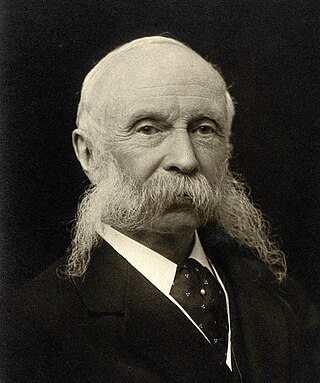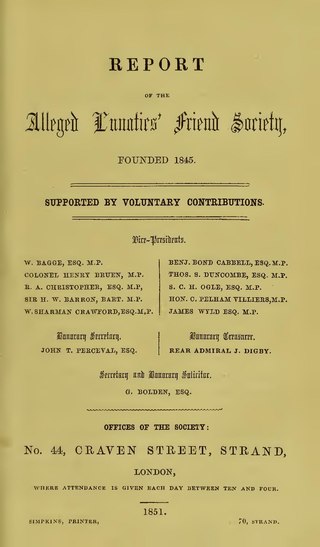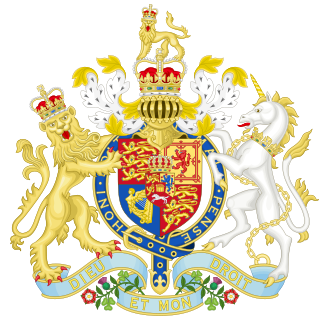Related Research Articles
The Lunacy/Lunatics Act 1845 and the County Asylums Act 1845 formed mental health law in England and Wales from 1845 to 1890. The Lunacy Act's most important provision was a change in the status of mentally ill people to patients.

Sir James Crichton-Browne MD FRS FRSE was a leading Scottish psychiatrist, neurologist and eugenicist. He is known for studies on the relationship of mental illness to brain injury and for the development of public health policies in relation to mental health. Crichton-Browne's father was the asylum reformer Dr William A.F. Browne, a prominent member of the Edinburgh Phrenological Society and, from 1838 until 1857, the superintendent of the Crichton Royal at Dumfries where Crichton-Browne spent much of his childhood.

Sunnyside Royal Hospital was a psychiatric hospital located in Hillside, north of Montrose, Scotland. It closed in 2011 and is now used for housing.
Lunacy Act is a stock short title used in the United Kingdom for legislation relating to mental illness.
The Commissioners in Lunacy or Lunacy Commission were a public body established by the Lunacy Act 1845 to oversee asylums and the welfare of mentally ill people in England and Wales. It succeeded the Metropolitan Commissioners in Lunacy.

The Crichton is an institutional campus in Dumfries in southwest Scotland. It serves as a remote campus for the University of Glasgow, the University of the West of Scotland, Dumfries and Galloway College, and the Open University. The site also includes a hotel and conference centre, and Crichton Memorial Church, set in a 100-acre (40-hectare) park. The campus was established in the 19th century as the Crichton Royal Hospital, a psychiatric hospital.

The Alleged Lunatics' Friend Society was an advocacy group started by former asylum patients and their supporters in 19th-century Britain. The Society campaigned for greater protection against wrongful confinement or cruel and improper treatment, and for reform of the lunacy laws. The Society is recognised today as a pioneer of the psychiatric survivors movement.

Dr William Alexander Francis Browne (1805–1885) was one of the most significant British asylum doctors of the nineteenth century. At Montrose Asylum (1834–1838) in Angus and at the Crichton Royal in Dumfries (1838–1857), Browne introduced activities for patients including writing, group activity and drama, pioneered early forms of occupational therapy and art therapy, and initiated one of the earliest collections of artistic work by patients in a psychiatric hospital. In an age which rewarded self-control, Browne encouraged self-expression and may therefore be counted alongside William Tuke, Vincenzo Chiarugi and John Conolly as one of the pioneers of the moral treatment of mental illness. Sociologist Andrew Scull has identified Browne's career with the institutional climax of nineteenth century psychiatry.
"Browne was one of the reformers of the asylum care of the insane whose improvements and innovations were chronicled in his annual reports from The Crichton Royal Institution, but who in addition published almost on the threshold of his career a sort of manifesto of what he wished to see accomplished...." Richard Hunter and Ida Macalpine (1963) Three Hundred Years of Psychiatry 1535–1860, page 865.

Woodilee Hospital was a psychiatric institution situated in Lenzie, East Dunbartonshire, Scotland.

The Lunacy Act 1886 was an Act of the Parliament of the United Kingdom. It provided a mechanism for a Member of Parliament who was judged to be of unsound mind to be removed from his seat.

Sir John Batty Tuke PRCPE FRSE LLD was one of the most influential psychiatrists in Scotland in the late nineteenth century, and a Unionist Member of Parliament (MP) from 1900 to 1910. Tuke's career in Edinburgh from 1863 to 1910 spanned a period of significant social and political changes in asylum governance and care in Scotland. Tuke's professional success in public and private practice and his powerful role in several prominent medical societies allowed him to influence his colleagues toward a more physiological understanding of mental illness and its treatment.

Murthly is a village in Perth and Kinross, Scotland. It lies on the south bank of the River Tay, 5 miles southeast of Dunkeld, and 9+1⁄2 miles north of Perth. Perth District Asylum, later known as Murthly Hospital, was opened in the village on 1 April 1864 for 'pauper lunatics'. It was the second district asylum to be built in Scotland under the terms of the 1857 Lunacy (Scotland) Act. It closed in 1984 and was later demolished. The village has a stone circle, in the former grounds of the hospital. The village formerly had a railway station on the Perth and Dunkeld Railway, which closed in 1965.

Sir Arthur Mitchell MD LLD was a Scottish doctor involved in the study and care of patients with mental illness. He served on several public commissions, and wrote widely on history and anthropology.

Murthly Hospital, previously known as Murthly Asylum, Perth District Asylum and Perth and District Mental Hospital was a psychiatric hospital in Murthly, Perthshire which operated for 120 years.
Mental health in the United Kingdom involves state, private and community sector intervention in mental health issues. One of the first countries to build asylums, the United Kingdom was also one of the first countries to turn away from them as the primary mode of treatment for the mentally ill. The 1960s onwards saw a shift towards Care in the Community, which is a form of deinstitutionalisation. The majority of mental health care is now provided by the National Health Service (NHS), assisted by the private and the voluntary sectors.

Bellsdyke Hospital, also known as Stirling District Lunatic Asylum ('SDLA') or Stirling District Asylum, is a former psychiatric hospital at Larbert, Falkirk that was opened in June 1869 and largely closed in 1997. It was an asylum set up by the Stirling District Lunacy Board.

The Lunacy (Scotland) Act 1857 formed mental health law in Scotland from 1857 until 1913.

The Royal Dundee Liff Hospital, previously known as Dundee Lunatic Asylum and Dundee Royal Lunatic Asylum, was a mental health facility originally established in 1812 in Dundee, Scotland. It was originally located in premises in Albert Street Dundee, but later moved out of the town to new buildings in the nearby parish of Liff and Benvie. Buildings at Liff included Greystanes House, which was the main building, and, Gowrie House, which was the private patients' facility. Both Grade B listed buildings.

The Lunacy (Ireland) Act 1821 formed the basis of mental health law in Ireland from 1821 until 2015.
The Commissioners in Lunacy for Ireland or Lunacy Commission for Ireland were a public body established by the Lunacy (Ireland) Act 1821 to oversee asylums and the welfare of mentally ill people in Ireland.
References
- ↑ Barfoot, M (1 January 2009). "The 1815 Act to Regulate Madhouses in Scotland: A Reinterpretation". Medical History. 53 (1): 57–76. doi:10.1017/s0025727300003318. PMC 2629162 . PMID 19190749.
- ↑ "Lunatics (Scotland)". Hansard. 9 June 1857. Retrieved 25 April 2019.
- 1 2 3 4 "Lunacy Board (Scotland) (Salaries, etc.) Bill". Hansard. 2 April 1900. Retrieved 25 April 2019.
- ↑ "Lunacy Board (Scotland) (Salaries, etc.) Bill". Hansard. 22 March 1900. Retrieved 25 April 2019.
- ↑ "William Hugh Elliot-Murray-Kynynmound, 3rd Earl of Minto, KT". Cracrofts Peerage. Retrieved 25 April 2019.
- ↑ "Minto". Scottish Places. Retrieved 25 April 2019.
- ↑ "Walter George Hepburne-Scott, 9th Lord Polwarth". The Peerage. Retrieved 25 April 2019.
- ↑ Walford, Edward (1919). "The county families of the United Kingdom; or, Royal manual of the titled and untitled aristocracy of England, Wales, Scotland, and Ireland". Spottiswood, Ballentyne and Co.
- ↑ Edinburgh Post Office directories
- ↑ Edinburgh Post Office directory 1905
- ↑ "Background to the Lunacy (Scotland) Act, 1857". Asylum Geographies. 13 November 2012. Retrieved 22 April 2019.
- ↑ Keane, p. 30
- ↑ Farquharson, Lauren (2017). "A 'Scottish Poor Law of Lunacy'? Poor Law, Lunacy Law and Scotland's parochial asylums" (PDF). History of Psychiatry. 28 (1): 15–28. doi:10.1177/0957154X16678123. PMID 27895195. S2CID 20353931.
- 1 2 3 Keane, p. 399
- ↑ "Mental Deficiency and Lunacy (Scotland) Act 1913". Hansard. Retrieved 25 April 2019.